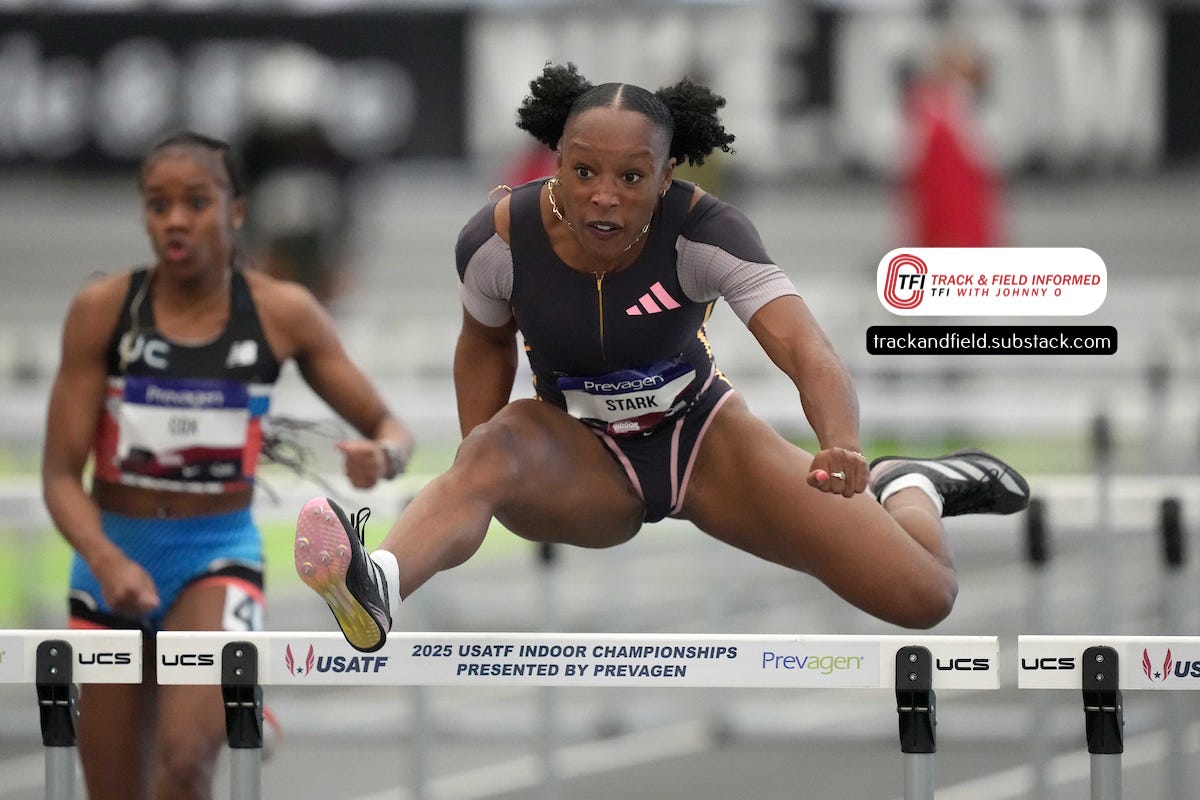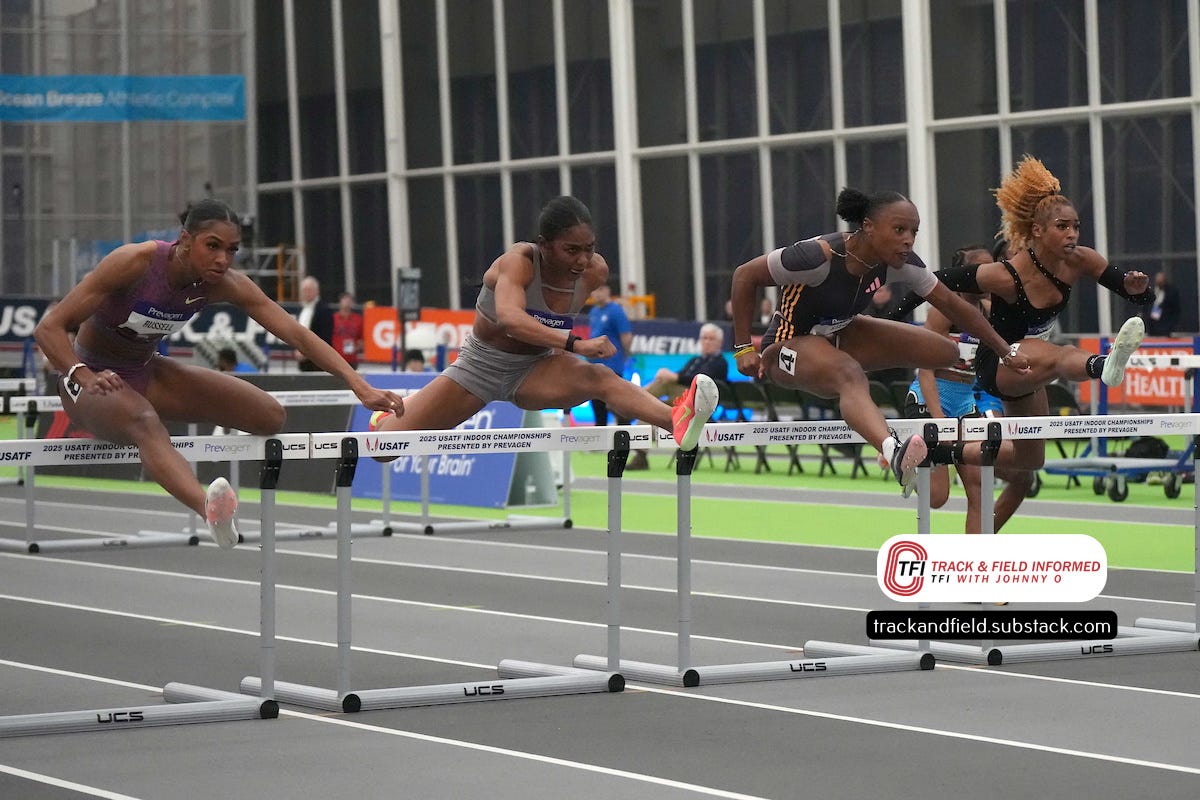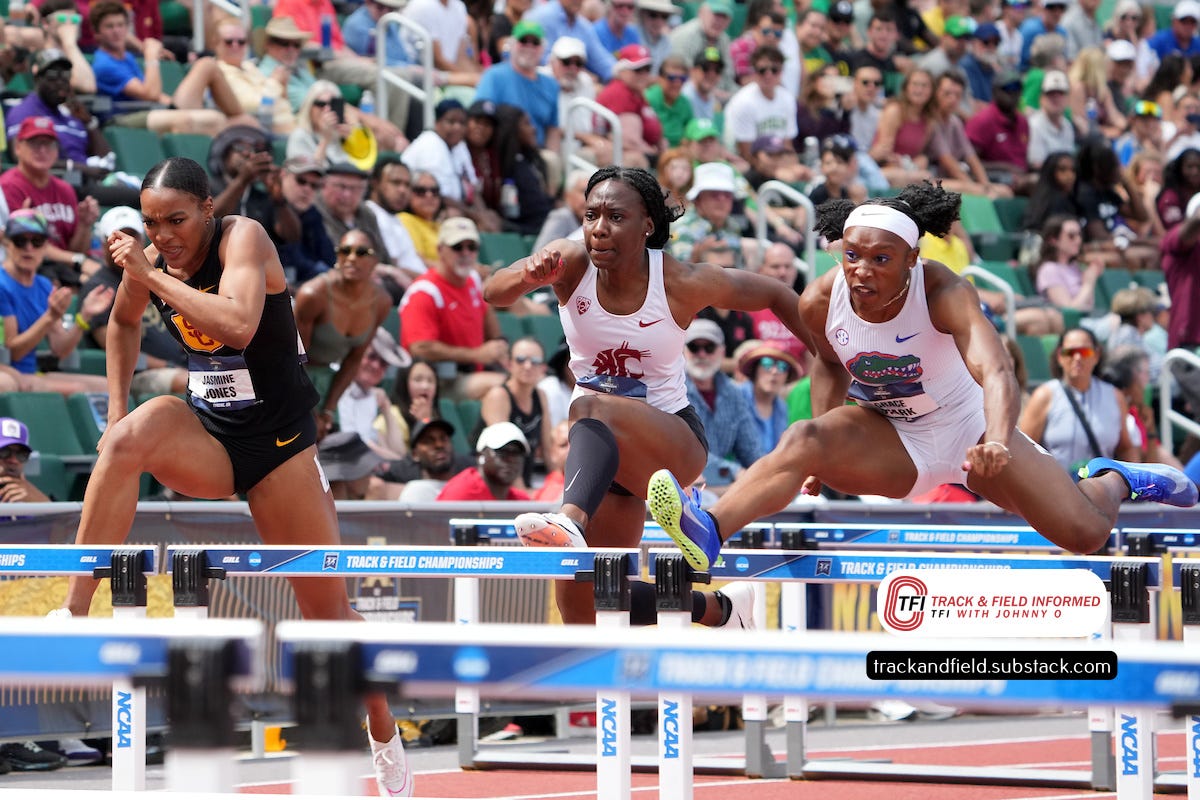Stark looks forward after bouncing back
Hurdler who overcame severe injury is medal contender in World indoor champs

Whether a quarterback in football, a slugger in baseball or softball, a basketball point guard, soccer midfielder or dominant tennis player, elite performers often say the sport in which they excel seemed to slow down for them as they progressed.
That is not the case for American track and field athlete Grace Stark, who will run in the women’s 60-meter hurdles on the final day of the World Athletics Indoor Championships in Nanjing, China, on Sunday.
The three-day meet begins at 10:05 p.m., local time on Friday morning, which is 10:05 p.m., Eastern Daylight Time, Thursday in the U.S.
“The better you get, the more the race speeds up,” Stark said in a telephone interview earlier this month. “You obviously know what you’re doing, but it is a bit of a blur, at least for me. Those hurdles are not moving, and the faster you run, the faster you come up on them… For me to have my best results, I need to focus on myself, not my competitors, and stay composed.”
The 23-year-old Stark, expected to contend for a medal in Nanjing, has had a lot of high-quality results in the last 15 months.
As a senior at the University of Florida, she placed second in the 60 hurdles in the NCAA indoor championships last March before winning the 100 hurdles in the NCAA outdoor championships in June.
Stark felt like the victory in the 100 hurdles — in a personal best to boot — capped her comeback from a catastrophic injury she sustained in May of 2022 when she crashed to the track after hitting one hurdle and getting tangled up with another during the Southeastern Conference championships.
“I just wanted to be competitive again,” she said when asked about her goals entering 2024. “I wanted to be as good, or better, than I had been before the injury. Winning the NCAA title indoors would have completed the comeback, But I think getting second place gave me a lot of fire for the outdoor season.”
Not long after her victory in the NCAA outdoor championships, Stark asked herself, ‘What’s the next step for me?’
The answer came in the U.S. Olympic Team Trials in Eugene. Oregon, three weeks later when she placed third with a 12.31-second clocking that slashed .14 seconds off her previous best and moved her into a tie for fifth on the all-time U.S. performer list.
She then placed fifth in the Olympic Games in Paris in August before posting three runner-up finishes and two fourth-place efforts in five races on the European circuit.
“Of course I wanted to medal,” Stark said of the Olympic Games. “But with everything I had gone through, and after some reflecting an hour or two later, I had to admit that I had not seen myself finishing fifth in the Olympic Games when I started the season… I was able to get out of that slump and really relish the moment.”
Her performance was worth savoring as Stark had suffered a tibial plateau fracture, a torn meniscus, and a strained anterior cruciate ligament in the final of the 100 hurdles in the 2022 SEC championships.
Stark said the injury occurred when she hit the sixth of 10 hurdles, tried to get over the seventh barrier while off balance and eventually came down hard on the track.
The fracture to the tibia bone in her lower left leg was particularly severe because it was a complete break and it occurred vertically, rather than horizontally.

While Stark was in some pain as she was taken from the track, she figured she had dislocated her left knee. But her mom, Rene’, who is a registered nurse, took one look at here adopted daughter’s knee and leg in the medical area and could tell that her tibia was broken.
“I knew that with the amount of swelling in her knee and the way her leg was shaped that it was out of alignment,” Rene’ said.
Rene’ added that others around Grace, such as Florida coach Mike Holloway, initially thought the injury was less severe than it was and seemed hopeful that Grace might be able to continue her season after some rehabilitation and recovery time.
Grace did not want to hear her mom’s prognosis of a broken leg, as she had won the 60 hurdles in the NCAA indoor championships in March and lowered her best in the 100 hurdles to 12.58 three weeks prior to the SEC meet. But she underwent surgery nine days after sustaining the injury and the procedure involved anchoring a titanium plate and seven screws into her tibia in an effort to repair it and help it heal.
Rene’ said the lead surgeon told her that the break was one of the worst she had ever seen and Grace’s career as an elite hurdler was over.
Grace herself conducted research on the injury and came to the conclusion that she had a three-percent chance of ever being the hurdler she had been.
“It definitely was a career-ending injury and I thought my career was over,” Grace said. “But no one else in my camp did. At one point, I was like, ‘You guys aren’t hearing what the doctor said.’ ”
That might have been the case, but with the coaches, trainers, and physical therapists at Florida taking an “all hands on deck” approach to a long, challenging, and often painful rehabilitation process, Grace ran a 60-meter race in a low-key meet in early February of 2023 before clocking 7.45 in the 60 and 8.18 in the 60 hurdles in preliminary heats of the SEC championships 10 days later.
Her times did not advance her to the final of either event and they were well off her personal bests of 7.10 and 7.78 that she had set prior to the injury. But they gave her a starting point from which to proceed.
“The time wasn’t great, but I was just glad it wasn’t slower,” she said while speaking about the 60 hurdles. “I was glad I got it done. A time had been set. We had somewhere to start, to move on from. It could have been worse. It could have been 8.9.”
She continued to make progress during the outdoor season as she ran 13.01 to place sixth in the 100 hurdles in the SEC championships, before running a wind-aided 12.72 to finish fifth in the NCAA championships, and a season best of 12.70 for eighth in the USA Track & Field Outdoor Championships.
She could have continued racing at that point, but she decided against it as she was physically and emotionally drained after having completed her requirements for an undergraduate degree in Health Education and Behavioral Science, as well as working extensive hours in an internship.
She also underwent surgery in August to remove the titanium plate and six of the seven screws from the initial procedure.
It seemed to be a wise decision as she won her first three hurdle races of the collegiate indoor season last year before finishing second to Jasmine Jones of USC in the NCAA championships.
She then embarked on an outdoor season — while working toward a certificate in Sports Management — that saw her lower her personal best in the 100 hurdles to 12.56 in mid-April before trimming that mark in 12.53 in winning the SEC title four weeks later.
She ran under 12.50 seconds for the first time in her career when she won the NCAA championships in 12.47. And while that time put her third on the yearly U.S. performer list at the time, she figured she would need to run faster to place among the top three finishers in the Olympic Trials and earn a spot on the Olympic team for Paris.

“I know how these girls are,” she said when talking about her fellow competitors entering the Olympic Trials. “They’re going to show up for this meet… A 12.4 is not going to make the team. I had run 12.4 at that point, but I knew it was going to take a 12.3 to make the team and I hadn’t run that yet.”
After clocking 12.52 to finish first in a first-round heat of the Trials on June 28, she lowered her personal best to 12.45 while placing second in the third of three semifinals the following day.
Grace was feeling pretty good about things as she sat in the stands with Rene’ and her dad, Jim, after that race. But she became very serious when she looked up the cumulative results from the semifinals on her phone and saw that Alaysha Johnson, Tonea Marshall, and Masai Russell had all run 12.36 during that round.
“She said, ‘Oh crap,’ ” Rene’ said. “She was like, ‘I’m going to have to throw down a 12.3 and I don’t know if I have a 12.3 in me.’ ”
Coach Holloway was convinced that she did and Grace remembers him telling her shortly before the final on June 30 that “I’ll see you in 12.3, when you’re an Olympian.”
And Stark did more that just dip under 12.40 in the ensuing race, as her 12.31 clocking crushed her personal best of 12.45 while finishing third behind Russell and Johnson, who also set career bests of 12.25 and 12.31 while finishing first and second.
Russell, who would go on to win the Olympic title, set a Trials record with her performance while moving into a tie for fourth on the all-time performer list, and Stark ran the fastest third-place time in history.
“We’re all just so excited. It’s so much fun,” she said when talking about the on-track celebration that occurred after she and Johnson realized they had grabbed the second and third spots on the Olympic team behind Russell. “It was such a crazy moment to go from where I was on the track two years earlier with a broken leg to now I’m an Olympian.”
While Jim and Rene’ Stark were thrilled for their daughter, so was John Kababik, who was Grace’s coach when she attended Lakeland High School in White Lake, Michigan.
Kababik, who says that Grace taught him a lot about the hurdles and he taught her a little about track during their four years working together, had always felt that there were no limits on what she could do because of her combination of athleticism, determination, and work ethic. But he had wondered if she would be able to rebound from her injury.
“The first thing that went through my mind was will she recover physically and will she recover mentally?,” he said. “Not only is it hard to recuperate your body from an injury such as that, but it’s also hard to recuperate mentally… But if anyone could do it, Grace would be the one.”
While Stark was unable to lower her personal best during the remainder of a long 2024 outdoor season, she ran faster than her pre-year best of 12.58 on 16 occasions. And the confidence she gained last year has carried over to this indoor season in which she has lowered her personal best to 7.75 in the 60 hurdles and also posted times of 7.76, 7.81, and 7.82 (twice).
She has finished second in each of the four finals in which she had run, but her consistency makes her a potential gold medalist in a World title meet that is scheduled to include European record-holder Ditaji Kambundji of Switzerland, who has run 7.67 this season, Nadine Visser of the Netherlands, who has clocked 7.72, and Ackera Nugent of Jamaica, who has timed 7.75.
Russell ran 7.74 in defeating Stark (7.76) for the USA Track & Field Indoor title last month, but she has since been focused on training for the outdoor season.
“I want to get a medal of course,” Stark said about the World championships. “It’s going to be a really great competition, but I think I have a chance to get a medal. I’m super excited to compete on the world stage again. I had such a great experience in Paris and I hope to have another great experience in China.”
Note — All six sessions of the World Athletics Indoor Championships in Nanjing, China, will be televised/streamed on the Peacock network in the U.S. There is a 12-hour time difference between Nanjing and the Eastern time zone, so the start times for the six sessions are as follows: March 20 (Thursday), 10:05 p.m., Eastern Daylight Time; March 21 (Friday), 6:20 a.m.; March 21 (Friday), 9:55 p.m.; March 22 (Saturday), 6:20 a.m.; March 22 (Saturday), 9:05 p.m.; March 23 (Sunday), 7:25 a.m.
The following link will take you an event schedule and live results for the meet.



